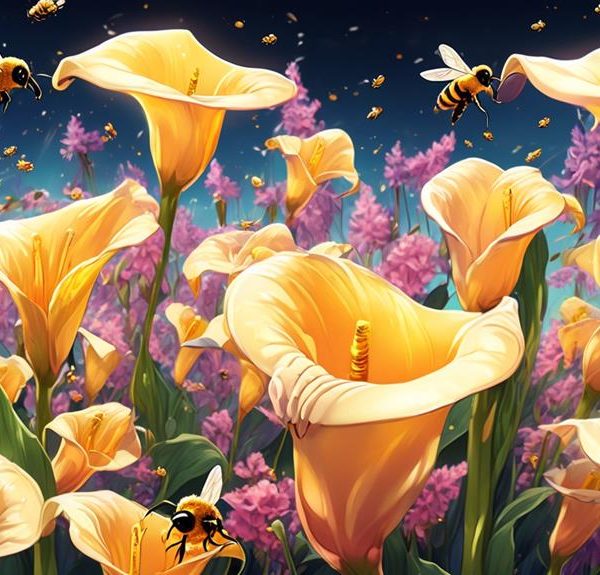Yearning to understand the intricate dance between bees and California Poppies? Delve into the surprising truths behind this fascinating relationship.
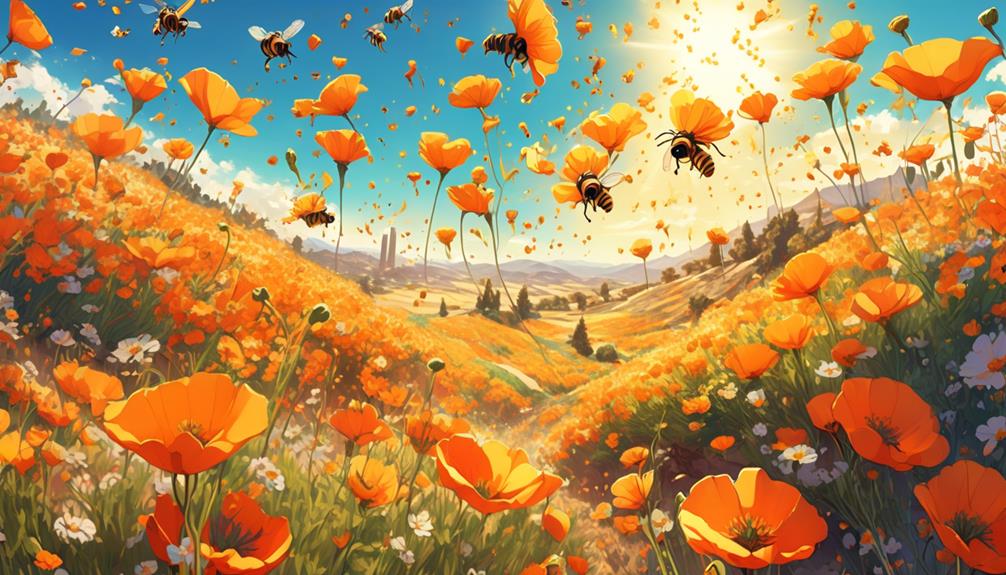
Do Bees Like California Poppies
You'd swear that California poppies are the bees' equivalent of a five-star restaurant, their vibrant blooms seemingly irresistible to these industrious pollinators. But, is it really the case? Do bees actually favor these golden beauties over other flowers, or is this just a colorful myth?
The relationship between bees and California poppies is fascinating, and it's one that interweaves the complex dance of nature in ways you might not anticipate.
As we explore this intriguing subject, you'll discover just how significant a tiny flower can be in the grand scheme of things, leaving you on the edge of your seat, anxious to uncover more.
Key Takeaways
- Bees play a vital role in the pollination of California poppies, ensuring their genetic diversity and survival.
- California poppies attract bees with their vibrant color, enticing scent, and rich nectar.
- The physical structure of California poppies requires the buzzing of bees to release pollen.
- Environmental factors, such as flower availability, and bees' sensory capabilities influence their preferences for California poppies.
Understanding Bee Pollination Patterns
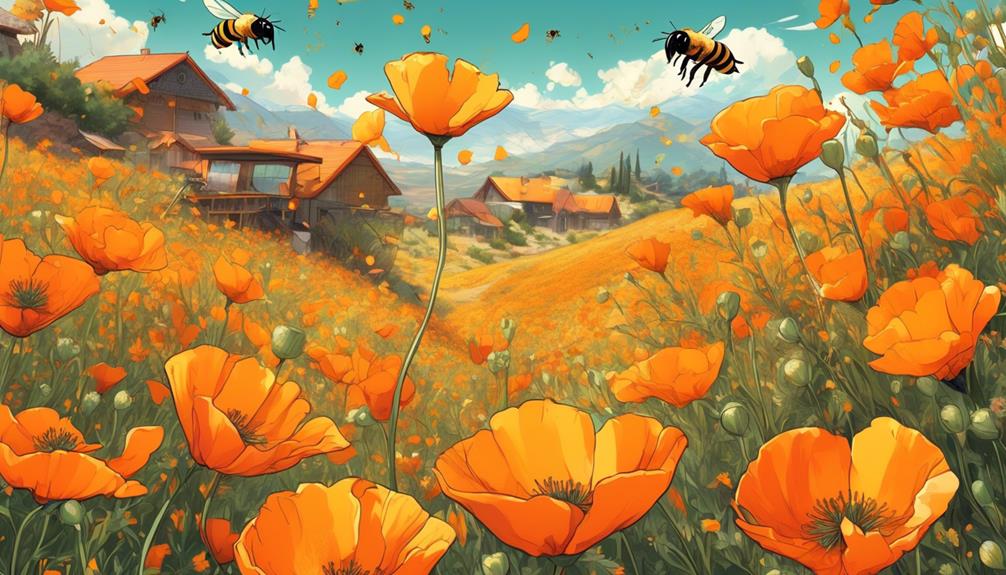
To fully grasp how bees pollinate, you need to delve into the intricacies of their behavioral patterns, particularly as they interact with California poppies. You see, bees play an essential role in pollination – a process vital for plant reproduction. They carry pollen grains from the male parts of a flower to its female counterpart, facilitating fertilization.
When a bee lands on a California poppy, it's not just random. The bee is attracted by the flower's vivid color and the scent it emits. The insect's body, covered in tiny hairs, becomes dusted with pollen as it moves around the bloom in search of nectar. It's a symbiotic relationship; the poppy provides food for the bee, while the bee aids the poppy's survival through pollination.
However, not all bees pollinate the same way. Honeybees, for instance, tend to be more methodical. They'll typically stick to one type of flower, ensuring pollen doesn't get mixed. Bumblebees, on the other hand, are a bit more haphazard, flitting between different species.
Understanding these patterns can help you appreciate not only the complexity of nature but also the critical role bees play in our ecosystem.
The Allure of California Poppies
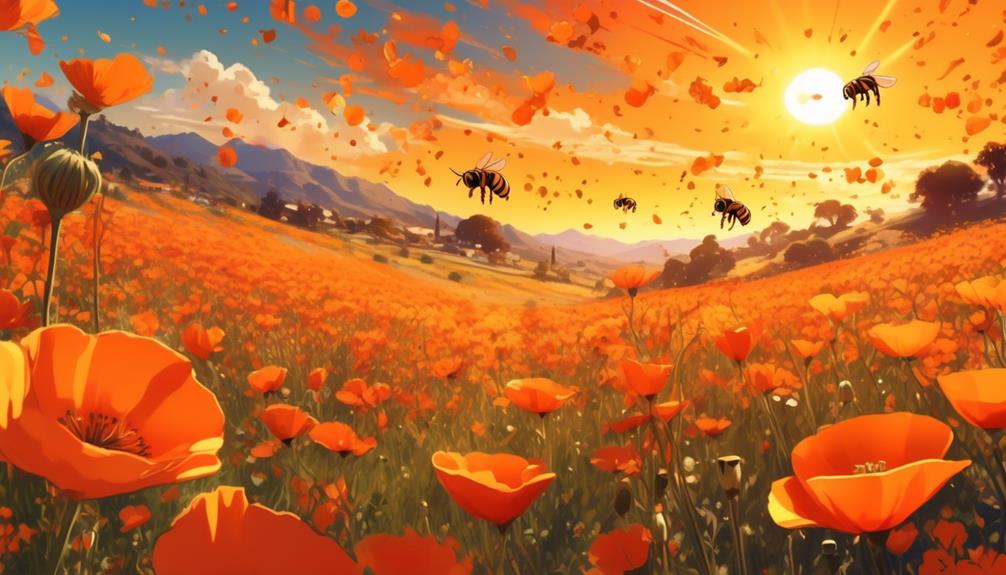
While appreciating these intricate bee behaviors, you can't help but be drawn to the allure of their primary target – the California poppy. This vibrant flower, scientifically known as Eschscholzia californica, is a captivating sight with its brilliant orange petals. It's more than just its visual appeal that makes it attractive to bees. This particular poppy secretes a nectar that bees find irresistible.
The nectar, rich in sugars, provides an energy source for the bees. But it's not just the sweetness that bees are after. The California poppy also boasts a unique scent profile, a blend of volatile organic compounds that bees find enticing. These compounds play a crucial role in signaling bees to the flower's presence.
Furthermore, the California poppy's physical structure adds to its appeal. The flower's wide, flat petals make it an accessible landing pad for bees. The deep-seated reproductive parts of the flower further encourage bee visits, as they require a bee's buzz to release their pollen.
In short, the California poppy's allure lies in its unique combination of visual beauty, sweet nectar, enticing scent, and structural design.
Bees' Interaction With California Poppies
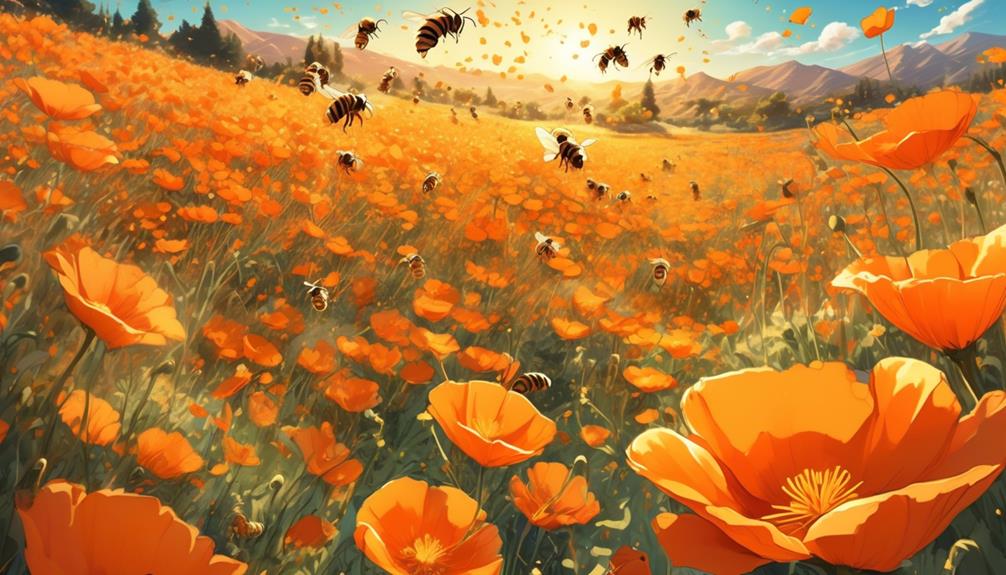
When you observe bees interacting with California poppies, you'll notice a highly efficient and finely-tuned relationship, critical to the pollination process and survival of both species. The bees benefit from the poppies' copious nectar supply, while the poppies, in turn, receive the benefit of pollination, ensuring genetic diversity and continuity.
The bee's interaction is systematic. It lands on the flower's broad petals, which serve as a landing platform. The poppy's flower shape and design guide the bee to its anthers and pistil, the reproductive parts. The bee, while feasting on the nectar, inadvertently picks up pollen grains on its body, particularly its hind legs, where bees have specialized structures known as 'pollen baskets.'
As the bee moves to the next flower, some of these pollen grains rub off onto the pistil of the new flower, thereby fertilizing it. This is known as cross-pollination, vital for the genetic diversity and survival of the California poppy species.
This bee-flower interaction isn't accidental but is the result of millions of years of co-evolution. Each species relies on the other for survival, showcasing a magnificent example of symbiosis in nature.
Factors Influencing Bees' Flower Preferences
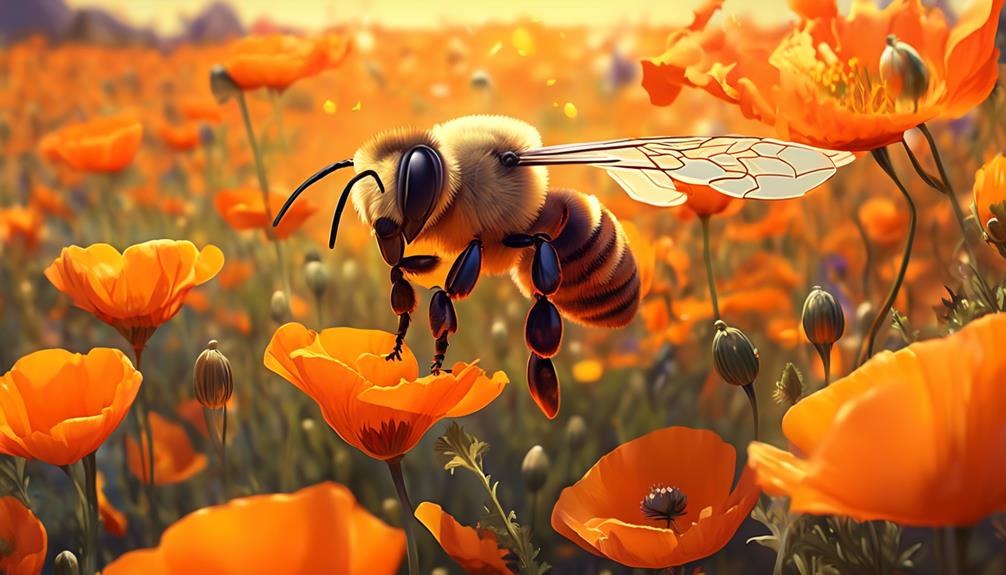
Understanding the factors that influence a bee's preference for certain flowers, like the California poppy, requires delving into the intricacies of their sensory capabilities and their environment. Bees have an acute sense of smell, which they use to locate flowers rich in nectar. The scent of a flower, therefore, plays a crucial role in a bee's choice.
In addition to scent, the color and shape of a flower can also attract bees. Bees are drawn to bright colors, particularly blue and yellow, and certain flower shapes are easier for bees to access nectar from. The California poppy, with its vibrant orange hue, isn't necessarily a bee's top choice based on color alone. However, its shape is quite accessible for bees, making it an attractive option.
Lastly, environmental factors greatly impact a bee's flower preference. If a certain type of flower is abundant in a bee's environment, such as the California poppy in certain regions, bees are more likely to frequent these flowers. It's a matter of availability.
Impact on Poppy Pollination and Growth
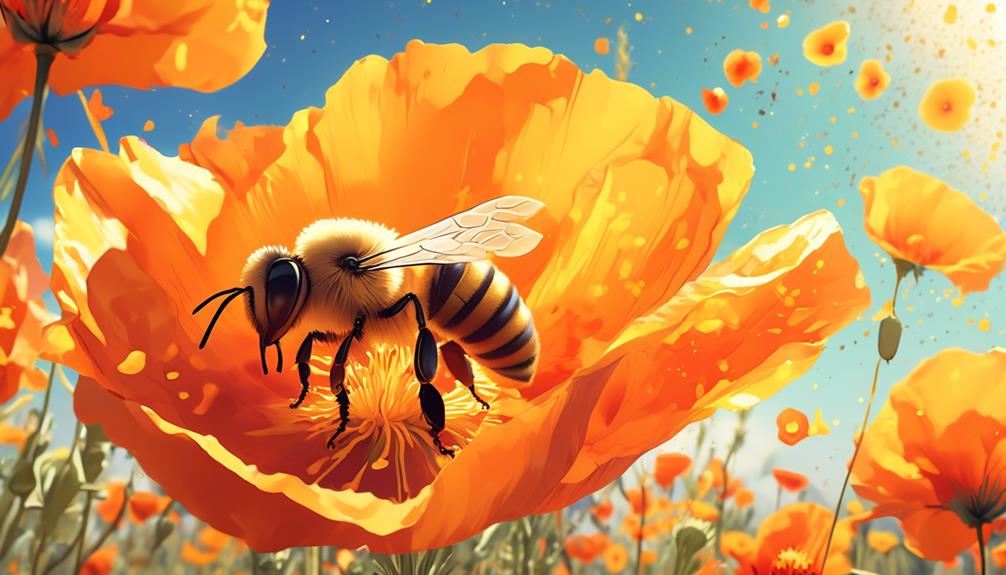
So, given a bee's affinity for accessible flowers like the California poppy and its prevalence in certain regions, it's worth considering how this relationship affects the pollination and growth of these vibrant plants.
Bees play a critical role in poppy pollination. As they move from flower to flower, they inadvertently carry pollen on their bodies, facilitating cross-pollination. This process is essential for the poppies' genetic diversity and survival. Without bees, you'll see a significant decline in poppy populations.
Moreover, poppies, in turn, provide an abundant source of nectar and pollen for bees. This reciprocal relationship not only promotes the growth and reproduction of poppies but also supports the health and productivity of bee colonies.
However, it's important to note that changes in bee populations can directly impact this delicate balance. Factors like habitat loss, pesticide exposure, and climate change can reduce bee populations, leading to decreased poppy pollination and growth. So, preserving habitats and reducing harmful practices are crucial for maintaining this symbiotic relationship.
In essence, bees and California poppies share a mutualistic relationship that's integral to both their survival and the biodiversity of their habitats. This dynamic interaction underscores the importance of protecting both bees and poppies.
Frequently Asked Questions
What Other Types of Flowers Do Bees Commonly Pollinate in California Besides Poppies?"
You're curious about other flowers bees pollinate in California, aren't you? Well, bees aren't just attracted to poppies. They also love blossoms like lavender, sage, sunflowers, and wild lilacs. These plants are rich in nectar, which bees need for energy.
They're also drawn to almond trees, which bloom early and provide food when other sources are scarce. So, it's not just about poppies, bees have quite a diverse taste in flowers!
Are There Any Potential Risks for Bees When They Are Pollinating California Poppies?"
You're curious about potential risks for bees pollinating California poppies.
Generally, it's safe. However, if pesticides are used on the flowers, they could harm the bees.
Weather conditions also play a role. Cold or wet weather could make it difficult for bees to fly and collect pollen.
It's also important to note that not all poppies provide nectar, which can lead to nutritional deficiencies in bees if they're the primary food source.
Can California Poppies Survive Without Bee Pollination?"
Yes, California poppies can survive without bee pollination. They're self-pollinating plants, meaning they can fertilize themselves without the need for external pollinators.
However, bees can still aid in their pollination, increasing their reproduction rate. Though they're not totally reliant on bees, they certainly benefit from their presence.
It's a mutually beneficial relationship – bees get nectar and the poppies get a pollination boost.
What Are Some Other Pollinators of California Poppies Besides Bees?"
You're curious about other pollinators of California poppies besides bees.
Well, various insects, including butterflies and beetles, often visit these vibrant flowers. Even hummingbirds can serve as pollinators.
Wind also plays a role in the pollination of California poppies.
Each of these methods has its unique advantages, ensuring the poppies' successful reproduction.
It's all part of nature's stunningly intricate pollination process.
How Does the Climate in California Affect the Relationship Between Bees and California Poppies?"
Yes, bees are quite fond of California poppies. These flowers provide a rich source of nectar and pollen that bees need for nutrition. The bright orange color of the poppies also attracts bees.
As a bee visits a poppy for its resources, it inadvertently moves pollen from the male parts to the female parts of the flower, aiding in the poppy's reproduction. So, it's a beneficial relationship for both the bees and the poppies.
Conclusion
In conclusion, you'll find bees adore California poppies. These vibrant flowers attract them with their pollen and nectar. However, factors like season, weather conditions, and availability of other flowers can influence their preferences.
This bee-poppy interaction significantly impacts the pollination and growth of these poppies, making bees crucial for their survival. So, when you spot a bee buzzing around your California poppies, know it's playing a vital role in your garden's ecosystem.


